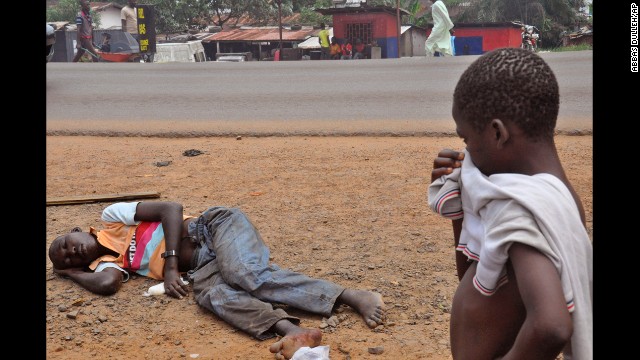 A child stops to look at a man who is suspected of suffering from the Ebola virus on a main street in Monrovia, Liberia, on Friday, September 12. Health officials say the current Ebola outbreak in West Africa is the deadliest ever. More than 4,700 cases have been reported since December, with more than 2,400 of them ending in fatalities, according to the World Health Organization.
A child stops to look at a man who is suspected of suffering from the Ebola virus on a main street in Monrovia, Liberia, on Friday, September 12. Health officials say the current Ebola outbreak in West Africa is the deadliest ever. More than 4,700 cases have been reported since December, with more than 2,400 of them ending in fatalities, according to the World Health Organization. 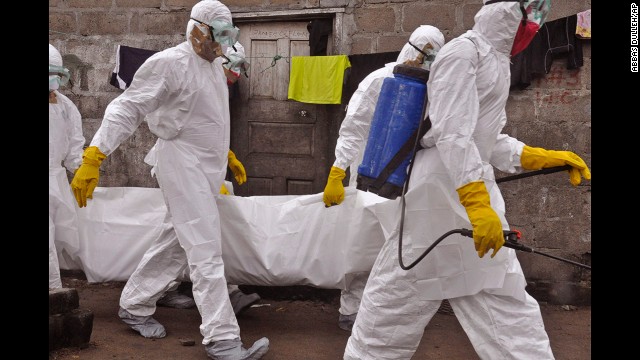 Health workers on Wednesday, September 10, carry the body of a woman who they suspect died from the Ebola virus in Monrovia.
Health workers on Wednesday, September 10, carry the body of a woman who they suspect died from the Ebola virus in Monrovia. 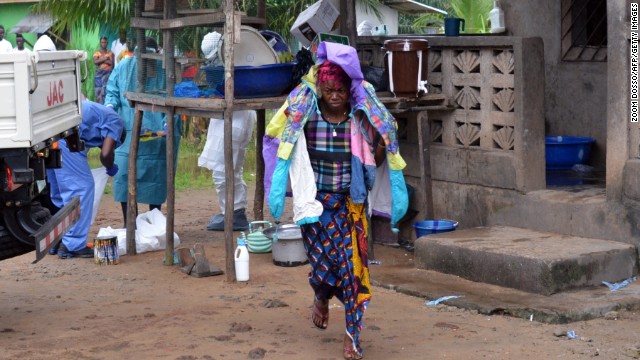 A woman in Monrovia carries the belongings of her husband, who died after he was infected by the Ebola virus.
A woman in Monrovia carries the belongings of her husband, who died after he was infected by the Ebola virus.  Five ambulances that were donated by the United States to help combat the Ebola virus are lined up in Freetown, Sierra Leone, on September 10 following a ceremony that was attended by Sierra Leone President Ernest Bai Koroma.
Five ambulances that were donated by the United States to help combat the Ebola virus are lined up in Freetown, Sierra Leone, on September 10 following a ceremony that was attended by Sierra Leone President Ernest Bai Koroma. 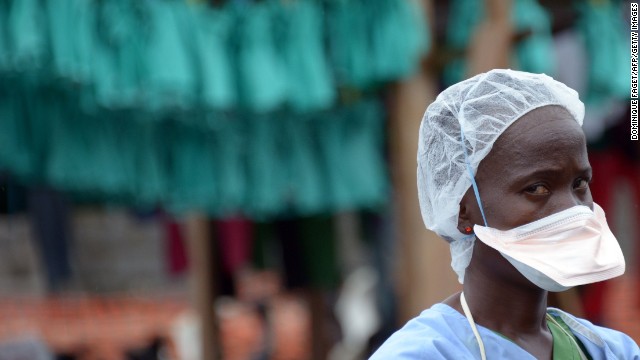 A health worker wears protective gear Sunday, September 7, at ELWA Hospital in Monrovia.
A health worker wears protective gear Sunday, September 7, at ELWA Hospital in Monrovia.  An ambulance transporting Dr. Rick Sacra, an American missionary who was infected with Ebola in Liberia, arrives at the Nebraska Medical Center in Omaha, Nebraska, on Friday, September 5. Sacra was being treated in the hospital's special isolation unit.
An ambulance transporting Dr. Rick Sacra, an American missionary who was infected with Ebola in Liberia, arrives at the Nebraska Medical Center in Omaha, Nebraska, on Friday, September 5. Sacra was being treated in the hospital's special isolation unit.  Medical workers from the Liberian Red Cross carry the body of an Ebola victim Thursday, September 4, in Banjol, Liberia.
Medical workers from the Liberian Red Cross carry the body of an Ebola victim Thursday, September 4, in Banjol, Liberia.  Health workers in Monrovia place a corpse into a body bag on September 4.
Health workers in Monrovia place a corpse into a body bag on September 4.  A rally against the Ebola virus is held in Abidjan, Ivory Coast, on September 4.
A rally against the Ebola virus is held in Abidjan, Ivory Coast, on September 4.  After an Ebola case was confirmed in Senegal, people load cars with household items as they prepare to cross into Guinea from the border town of Diaobe, Senegal, on Wednesday, September 3. Senegal has since closed its borders.
After an Ebola case was confirmed in Senegal, people load cars with household items as they prepare to cross into Guinea from the border town of Diaobe, Senegal, on Wednesday, September 3. Senegal has since closed its borders.  Crowds cheer and celebrate in the streets Saturday, August 30, after Liberian authorities reopened the West Point slum in Monrovia. The military had been enforcing a quarantine on West Point, fearing a spread of the Ebola virus.
Crowds cheer and celebrate in the streets Saturday, August 30, after Liberian authorities reopened the West Point slum in Monrovia. The military had been enforcing a quarantine on West Point, fearing a spread of the Ebola virus. 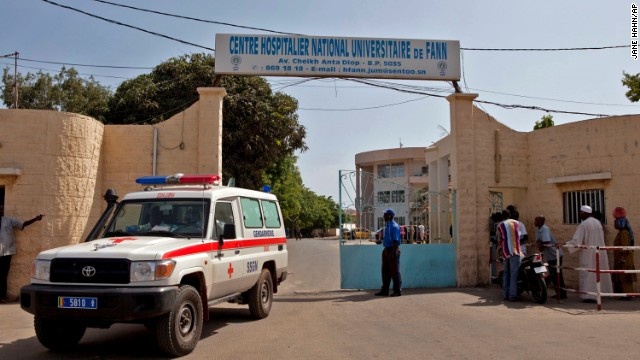 A ambulance leaves the University Hospital Fann in Dakar, Senegal, were a man was being treated for symptoms of the Ebola virus on Friday, August 29.
A ambulance leaves the University Hospital Fann in Dakar, Senegal, were a man was being treated for symptoms of the Ebola virus on Friday, August 29. 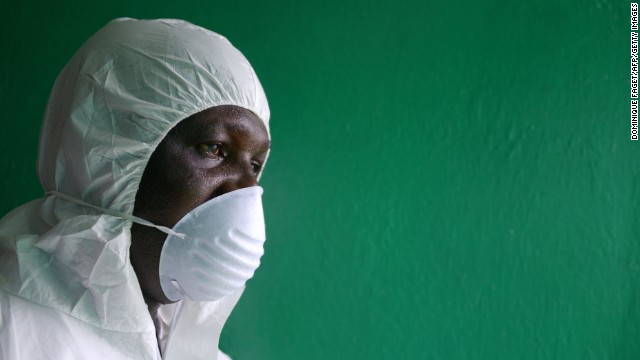 A health worker wearing a protective suit conducts an Ebola prevention drill at the port in Monrovia on August 29.
A health worker wearing a protective suit conducts an Ebola prevention drill at the port in Monrovia on August 29.  Senegalese Health Minister Awa Marie Coll-Seck gives a news conference August 29 to confirm the first case of Ebola in Senegal. She announced that a young Guinean had tested positive for the deadly virus.
Senegalese Health Minister Awa Marie Coll-Seck gives a news conference August 29 to confirm the first case of Ebola in Senegal. She announced that a young Guinean had tested positive for the deadly virus.  Volunteers working with the bodies of Ebola victims in Kenema, Sierra Leone, sterilize their uniforms on Sunday, August 24.
Volunteers working with the bodies of Ebola victims in Kenema, Sierra Leone, sterilize their uniforms on Sunday, August 24.  A Liberian health worker checks people for symptoms of Ebola at a checkpoint near the international airport in Dolo Town, Liberia, on August 24.
A Liberian health worker checks people for symptoms of Ebola at a checkpoint near the international airport in Dolo Town, Liberia, on August 24.  A guard stands at a checkpoint Saturday, August 23, between the quarantined cities of Kenema and Kailahun in Sierra Leone.
A guard stands at a checkpoint Saturday, August 23, between the quarantined cities of Kenema and Kailahun in Sierra Leone.  A burial team from the Liberian Ministry of Health unloads bodies of Ebola victims onto a funeral pyre at a crematorium in Marshall, Liberia, on Friday, August 22.
A burial team from the Liberian Ministry of Health unloads bodies of Ebola victims onto a funeral pyre at a crematorium in Marshall, Liberia, on Friday, August 22.  A humanitarian group worker, right, throws water in a small bag to West Point residents behind the fence of a holding area on August 22. Residents of the quarantined Monrovia slum were waiting for a second consignment of food from the Liberian government.
A humanitarian group worker, right, throws water in a small bag to West Point residents behind the fence of a holding area on August 22. Residents of the quarantined Monrovia slum were waiting for a second consignment of food from the Liberian government.  Dr. Kent Brantly leaves Emory University Hospital on Thursday, August 21, after being declared no longer infectious from the Ebola virus. Brantly was one of two American missionaries brought to Emory for treatment of the deadly virus.
Dr. Kent Brantly leaves Emory University Hospital on Thursday, August 21, after being declared no longer infectious from the Ebola virus. Brantly was one of two American missionaries brought to Emory for treatment of the deadly virus.  Brantly, right, hugs a member of the Emory University Hospital staff after being released from treatment in Atlanta.
Brantly, right, hugs a member of the Emory University Hospital staff after being released from treatment in Atlanta.  Family members of West Point district commissioner Miata Flowers flee the slum in Monrovia while being escorted by the Ebola Task Force on Wednesday, August 20.
Family members of West Point district commissioner Miata Flowers flee the slum in Monrovia while being escorted by the Ebola Task Force on Wednesday, August 20.  An Ebola Task Force soldier beats a local resident while enforcing a quarantine on the West Point slum on August 20.
An Ebola Task Force soldier beats a local resident while enforcing a quarantine on the West Point slum on August 20.  Local residents gather around a very sick Saah Exco, 10, in a back alley of the West Point slum on Tuesday, August 19. The boy was one of the patients that was pulled out of a holding center for suspected Ebola patients after the facility was overrun and closed by a mob on August 16. A local clinic then refused to treat Saah, according to residents, because of the danger of infection. Although he was never tested for Ebola, Saah's mother and brother died in the holding center.
Local residents gather around a very sick Saah Exco, 10, in a back alley of the West Point slum on Tuesday, August 19. The boy was one of the patients that was pulled out of a holding center for suspected Ebola patients after the facility was overrun and closed by a mob on August 16. A local clinic then refused to treat Saah, according to residents, because of the danger of infection. Although he was never tested for Ebola, Saah's mother and brother died in the holding center.  A burial team wearing protective clothing retrieves the body of a 60-year-old Ebola victim from his home near Monrovia on Sunday, August 17.
A burial team wearing protective clothing retrieves the body of a 60-year-old Ebola victim from his home near Monrovia on Sunday, August 17.  lija Siafa, 6, stands in the rain with his 10-year-old sister, Josephine, while waiting outside Doctors Without Borders' Ebola treatment center in Monrovia on August 17. The newly built facility will initially have 120 beds, making it the largest-ever facility for Ebola treatment and isolation.
lija Siafa, 6, stands in the rain with his 10-year-old sister, Josephine, while waiting outside Doctors Without Borders' Ebola treatment center in Monrovia on August 17. The newly built facility will initially have 120 beds, making it the largest-ever facility for Ebola treatment and isolation.  Brett Adamson, a staff member from Doctors Without Borders, hands out water to sick Liberians hoping to enter the new Ebola treatment center on August 17.
Brett Adamson, a staff member from Doctors Without Borders, hands out water to sick Liberians hoping to enter the new Ebola treatment center on August 17.  Workers prepare the new Ebola treatment center on August 17.
Workers prepare the new Ebola treatment center on August 17.  A body, reportedly a victim of Ebola, lies on a street corner in Monrovia on Saturday, August 16.
A body, reportedly a victim of Ebola, lies on a street corner in Monrovia on Saturday, August 16.  Liberian police depart after firing shots in the air while trying to protect an Ebola burial team in the West Point slum of Monrovia on August 16. A crowd of several hundred local residents reportedly drove away the burial team and their police escort. The mob then forced open an Ebola isolation ward and took patients out, saying the Ebola epidemic is a hoax.
Liberian police depart after firing shots in the air while trying to protect an Ebola burial team in the West Point slum of Monrovia on August 16. A crowd of several hundred local residents reportedly drove away the burial team and their police escort. The mob then forced open an Ebola isolation ward and took patients out, saying the Ebola epidemic is a hoax.  A crowd enters the grounds of an Ebola isolation center in the West Point slum on August 16. The mob was reportedly shouting, "No Ebola in West Point."
A crowd enters the grounds of an Ebola isolation center in the West Point slum on August 16. The mob was reportedly shouting, "No Ebola in West Point."  A health worker disinfects a corpse after a man died in a classroom being used as an Ebola isolation ward Friday, August 15, in Monrovia.
A health worker disinfects a corpse after a man died in a classroom being used as an Ebola isolation ward Friday, August 15, in Monrovia.  A boy tries to prepare his father before they are taken to an Ebola isolation ward August 15 in Monrovia.
A boy tries to prepare his father before they are taken to an Ebola isolation ward August 15 in Monrovia.  Kenyan health officials take passengers' temperature as they arrive at the Jomo Kenyatta International Airport on Thursday, August 14, in Nairobi, Kenya.
Kenyan health officials take passengers' temperature as they arrive at the Jomo Kenyatta International Airport on Thursday, August 14, in Nairobi, Kenya.  A hearse carries the coffin of Spanish priest Miguel Pajares after he died at a Madrid hospital on Tuesday, August 12. Pajares, 75, contracted Ebola while he was working as a missionary in Liberia.
A hearse carries the coffin of Spanish priest Miguel Pajares after he died at a Madrid hospital on Tuesday, August 12. Pajares, 75, contracted Ebola while he was working as a missionary in Liberia.  A member of the Centers for Disease Control and Prevention leads a training session on Ebola infection control Monday, August 11, in Lagos, Nigeria.
A member of the Centers for Disease Control and Prevention leads a training session on Ebola infection control Monday, August 11, in Lagos, Nigeria.  Health workers in Kenema, Sierra Leone, screen people for the Ebola virus on Saturday, August 9, before they enter the Kenema Government Hospital.
Health workers in Kenema, Sierra Leone, screen people for the Ebola virus on Saturday, August 9, before they enter the Kenema Government Hospital.  A health worker at the Kenema Government Hospital carries equipment used to decontaminate clothing and equipment on August 9.
A health worker at the Kenema Government Hospital carries equipment used to decontaminate clothing and equipment on August 9.  Health care workers wear protective gear at the Kenema Government Hospital on August 9.
Health care workers wear protective gear at the Kenema Government Hospital on August 9.  Paramedics in protective suits move Pajares, the infected Spanish priest, at Carlos III Hospital in Madrid on Thursday, August 7. He died five days later.
Paramedics in protective suits move Pajares, the infected Spanish priest, at Carlos III Hospital in Madrid on Thursday, August 7. He died five days later.  Nurses carry the body of an Ebola victim from a house outside Monrovia on Wednesday, August 6.
Nurses carry the body of an Ebola victim from a house outside Monrovia on Wednesday, August 6.  A Nigerian health official wears protective gear August 6 at Murtala Muhammed International Airport in Lagos.
A Nigerian health official wears protective gear August 6 at Murtala Muhammed International Airport in Lagos. 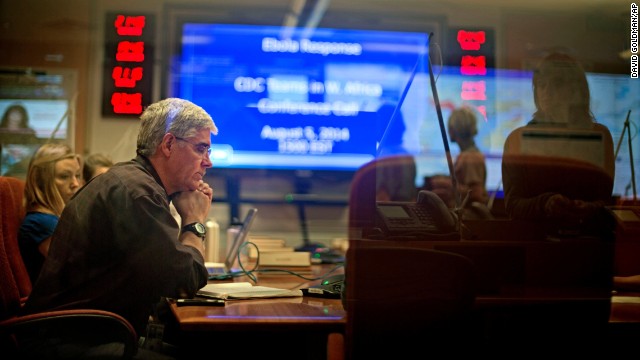 Officials with the Centers for Disease Control and Prevention in Atlanta sit in on a conference call about Ebola with CDC team members deployed in West Africa on Tuesday, August 5.
Officials with the Centers for Disease Control and Prevention in Atlanta sit in on a conference call about Ebola with CDC team members deployed in West Africa on Tuesday, August 5.  Aid worker Nancy Writebol, wearing a protective suit, gets wheeled on a gurney into Emory University Hospital in Atlanta on August 5. A medical plane flew Writebol from Liberia to the United States after she and her colleague Dr. Kent Brantly were infected with the Ebola virus in the West African country.
Aid worker Nancy Writebol, wearing a protective suit, gets wheeled on a gurney into Emory University Hospital in Atlanta on August 5. A medical plane flew Writebol from Liberia to the United States after she and her colleague Dr. Kent Brantly were infected with the Ebola virus in the West African country.  Nigerian health officials are on hand to screen passengers at Murtala Muhammed International Airport on Monday, August 4.
Nigerian health officials are on hand to screen passengers at Murtala Muhammed International Airport on Monday, August 4.  A man gets sprayed with disinfectant Sunday, August 3, in Monrovia.
A man gets sprayed with disinfectant Sunday, August 3, in Monrovia.  Dr. Kent Brantly, right, gets out of an ambulance after arriving at Emory University Hospital in Atlanta on Saturday, August 2. Brantly was infected with the Ebola virus in Africa, but he was brought back to the United States for further treatment.
Dr. Kent Brantly, right, gets out of an ambulance after arriving at Emory University Hospital in Atlanta on Saturday, August 2. Brantly was infected with the Ebola virus in Africa, but he was brought back to the United States for further treatment.  Nurses wearing protective clothing are sprayed with disinfectant Friday, August 1, in Monrovia after they prepared the bodies of Ebola victims for burial.
Nurses wearing protective clothing are sprayed with disinfectant Friday, August 1, in Monrovia after they prepared the bodies of Ebola victims for burial.  A nurse disinfects the waiting area at the ELWA Hospital in Monrovia on Monday, July 28.
A nurse disinfects the waiting area at the ELWA Hospital in Monrovia on Monday, July 28.  Liberian President Ellen Johnson Sirleaf, right, walks past an Ebola awareness poster in downtown Monrovia as Liberia marked the 167th anniversary of its independence Saturday, July 26. The Liberian government dedicated the anniversary to fighting the deadly disease.
Liberian President Ellen Johnson Sirleaf, right, walks past an Ebola awareness poster in downtown Monrovia as Liberia marked the 167th anniversary of its independence Saturday, July 26. The Liberian government dedicated the anniversary to fighting the deadly disease.  In this photo provided by Samaritan's Purse, Dr. Kent Brantly, left, treats an Ebola patient in Monrovia. On July 26, the North Carolina-based group said Brantly tested positive for the disease. Days later, Brantly arrived in Georgia to be treated at an Atlanta hospital, becoming the first Ebola patient to knowingly be treated in the United States.
In this photo provided by Samaritan's Purse, Dr. Kent Brantly, left, treats an Ebola patient in Monrovia. On July 26, the North Carolina-based group said Brantly tested positive for the disease. Days later, Brantly arrived in Georgia to be treated at an Atlanta hospital, becoming the first Ebola patient to knowingly be treated in the United States.  A 10-year-old boy whose mother was killed by the Ebola virus walks with a doctor from the aid organization Samaritan's Purse after being taken out of quarantine Thursday, July 24, in Monrovia.
A 10-year-old boy whose mother was killed by the Ebola virus walks with a doctor from the aid organization Samaritan's Purse after being taken out of quarantine Thursday, July 24, in Monrovia. 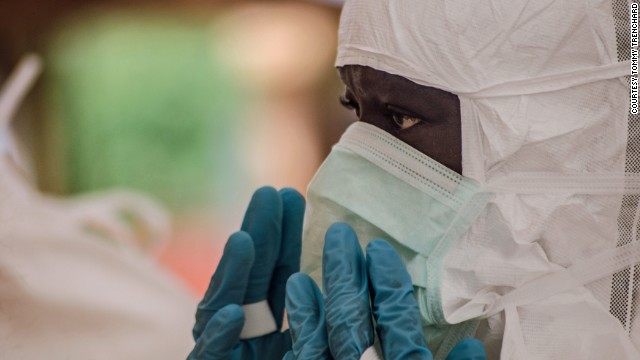 A doctor puts on protective gear at the treatment center in Kailahun, Sierra Leone, on Sunday, July 20.
A doctor puts on protective gear at the treatment center in Kailahun, Sierra Leone, on Sunday, July 20.  Members of Doctors Without Borders adjust tents in the isolation area in Kailahun on July 20.
Members of Doctors Without Borders adjust tents in the isolation area in Kailahun on July 20. 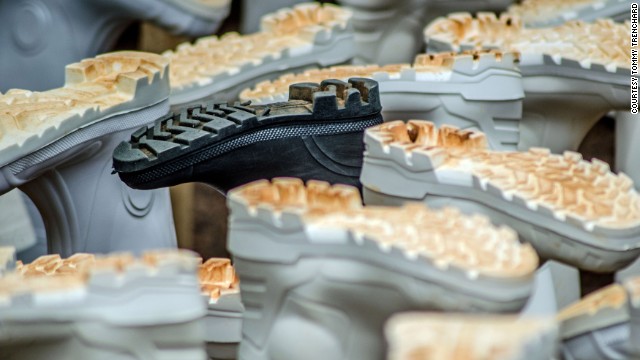 Boots dry in the Ebola treatment center in Kailahun on July 20.
Boots dry in the Ebola treatment center in Kailahun on July 20.  Red Cross volunteers prepare to enter a house where an Ebola victim died in Pendembu, Sierra Leone, on Friday, July 18.
Red Cross volunteers prepare to enter a house where an Ebola victim died in Pendembu, Sierra Leone, on Friday, July 18.  Dr. Jose Rovira of the World Health Organization takes a swab from a suspected Ebola victim in Pendembu on July 18.
Dr. Jose Rovira of the World Health Organization takes a swab from a suspected Ebola victim in Pendembu on July 18.  Red Cross volunteers disinfect each other with chlorine after removing the body of an Ebola victim from a house in Pendembu on July 18.
Red Cross volunteers disinfect each other with chlorine after removing the body of an Ebola victim from a house in Pendembu on July 18.  A dressing assistant prepares a Doctors Without Borders member before entering an isolation ward Thursday, July 17, in Kailahun.
A dressing assistant prepares a Doctors Without Borders member before entering an isolation ward Thursday, July 17, in Kailahun.  A doctor works in the field laboratory at the Ebola treatment center in Kailahun on July 17.
A doctor works in the field laboratory at the Ebola treatment center in Kailahun on July 17.  Doctors Without Borders staff prepare to enter the isolation ward at an Ebola treatment center in Kailahun on July 17.
Doctors Without Borders staff prepare to enter the isolation ward at an Ebola treatment center in Kailahun on July 17.  A health worker with disinfectant spray walks down a street outside the government hospital in Kenema on Thursday, July 10.
A health worker with disinfectant spray walks down a street outside the government hospital in Kenema on Thursday, July 10.  Dr. Mohamed Vandi of the Kenema Government Hospital trains community volunteers who will aim to educate people about Ebola in Sierra Leone.
Dr. Mohamed Vandi of the Kenema Government Hospital trains community volunteers who will aim to educate people about Ebola in Sierra Leone.  Police block a road outside Kenema to stop motorists for a body temperature check on Wednesday, July 9.
Police block a road outside Kenema to stop motorists for a body temperature check on Wednesday, July 9.  A woman has her temperature taken at a screening checkpoint on the road out of Kenema on July 9.
A woman has her temperature taken at a screening checkpoint on the road out of Kenema on July 9.  A member of Doctors Without Borders puts on protective gear at the isolation ward of the Donka Hospital in Conakry, Guinea, on Saturday, June 28.
A member of Doctors Without Borders puts on protective gear at the isolation ward of the Donka Hospital in Conakry, Guinea, on Saturday, June 28.  Airport employees check passengers in Conakry before they leave the country on Thursday, April 10.
Airport employees check passengers in Conakry before they leave the country on Thursday, April 10.  CNN's Dr. Sanjay Gupta, left, works in the World Health Organization's mobile lab in Conakry. Gupta traveled to Guinea in April to report on the deadly virus.
CNN's Dr. Sanjay Gupta, left, works in the World Health Organization's mobile lab in Conakry. Gupta traveled to Guinea in April to report on the deadly virus.  A Guinea-Bissau customs official watches arrivals from Conakry on Tuesday, April 8.
A Guinea-Bissau customs official watches arrivals from Conakry on Tuesday, April 8.  Egidia Almeida, a nurse in Guinea-Bissau, scans a Guinean citizen coming from Conakry on April 8.
Egidia Almeida, a nurse in Guinea-Bissau, scans a Guinean citizen coming from Conakry on April 8.  A scientist separates blood cells from plasma cells to isolate any Ebola RNA and test for the virus Thursday, April 3, at the European Mobile Laboratory in Gueckedou, Guinea.
A scientist separates blood cells from plasma cells to isolate any Ebola RNA and test for the virus Thursday, April 3, at the European Mobile Laboratory in Gueckedou, Guinea.  Members of Doctors Without Borders carry a dead body in Gueckedou on Friday, April 1.
Members of Doctors Without Borders carry a dead body in Gueckedou on Friday, April 1.  Gloves and boots used by medical personnel dry in the sun April 1 outside a center for Ebola victims in Gueckedou.
Gloves and boots used by medical personnel dry in the sun April 1 outside a center for Ebola victims in Gueckedou.  A health specialist works Monday, March 31, in a tent laboratory set up at a Doctors Without Borders facility in southern Guinea.
A health specialist works Monday, March 31, in a tent laboratory set up at a Doctors Without Borders facility in southern Guinea. 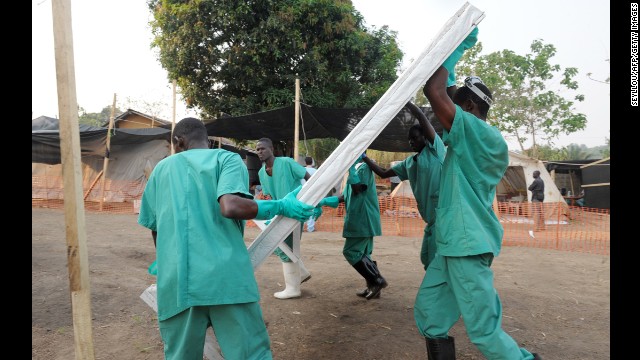 Health specialists work March 31 at an isolation ward for patients at the facility in southern Guinea.
Health specialists work March 31 at an isolation ward for patients at the facility in southern Guinea.  Workers associated with Doctors Without Borders prepare isolation and treatment areas Friday, March 28, in Guinea.
Workers associated with Doctors Without Borders prepare isolation and treatment areas Friday, March 28, in Guinea.
- Experts fear that Ebola will mutate and become spreadable via cough or sneeze
- Ebola is an RNA virus, meaning every time it copies itself, it mutates
- Most mutations mean nothing, but some could change the way the virus behaves
(CNN) -- Today, the Ebola virus spreads only through direct contact with bodily fluids, such as blood and vomit. But some of the nation's top infectious disease experts worry that this deadly virus could mutate and be transmitted just by a cough or a sneeze.
"It's the single greatest concern I've ever had in my 40-year public health career," said Dr. Michael Osterholm, director of the Center for Infectious Disease Research and Policy at the University of Minnesota. "I can't imagine anything in my career -- and this includes HIV -- that would be more devastating to the world than a respiratory transmissible Ebola virus."
Osterholm and other experts couldn't think of another virus that has made the transition from non-airborne to airborne in humans. They say the chances are relatively small that Ebola will make that jump. But as the virus spreads, they warned, the likelihood increases.
Every time a new person gets Ebola, the virus gets another chance to mutate and develop new capabilities. Osterholm calls it "genetic roulette."
 Doctor 'improving' after Ebola diagnosis
Doctor 'improving' after Ebola diagnosis  Why isn't Ebola containment working?
Why isn't Ebola containment working?  Gates Fdn. to donate $50M to Ebola fight
Gates Fdn. to donate $50M to Ebola fight  Writebol: I don't know how I got Ebola
Writebol: I don't know how I got Ebola As of Friday, there have been 4,784 cases of Ebola, with 2,400 deaths, according to the World Health Organization, which says the virus is spreading at a much faster rate now than it was earlier in the outbreak.
Ebola is an RNA virus, which means every time it copies itself, it makes one or two mutations. Many of those mutations mean nothing, but some of them might be able to change the way the virus behaves inside the human body.
"Imagine every time you copy an essay, you change a word or two. Eventually, it's going to change the meaning of the essay," said Dr. C.J. Peters, one of the heroes featured in "The Hot Zone."
That book chronicles the 1989 outbreak of Ebola Reston, which was transmitted among monkeys by breathing. In 2012, Canadian researchers found that Ebola Zaire, which is involved in the current outbreak, was passed from pigs to monkeys in the air.
Dr. James Le Duc, the director of the Galveston National Laboratory at the University of Texas, said the problem is that no one is keeping track of the mutations happening across West Africa, so no one really knows what the virus has become.
One group of researchers looked at how Ebola changed over a short period of time in just one area in Sierra Leone early on in the outbreak, before it was spreading as fast as it is now. They found more than 300 genetic changes in the virus.
"It's frightening to look at how much this virus mutated within just three weeks," said Dr. Pardis Sabeti, an associate professor at Harvard and senior associate member of the Broad Institute, where the research was done.
Even without mutating, the virus has overwhelmed efforts to stop it.
The group Doctors Without Borders says Monrovia, Liberia, needs 1,000 beds for Ebola patients but has only 240, and it has had to turn patients away, sending them back to neighborhoods where they will probably infect more people.
This week, a Pentagon spokesman said the United States is sending a 25-bed field hospital to Monrovia.
"A 25-bed hospital with nobody to staff it? That's not the scale we need to be thinking about," Le Duc said. "It's an absolute embarrassment. When there was a typhoon in the Philippines, the Navy was there in 48 hours and had billions of dollars in resources."
Osterholm commended groups like Doctors Without Borders but said uncoordinated efforts by individual organizations are no match for Ebola spreading swiftly through urban areas.
"This is largely dysfunctional. Nobody's in command, and nobody's in charge," he said. "It's like not having air traffic control at an airport. The planes would just crash into each other."
Funerals, ghost towns and haunted health workers
The roots of our Ebola fears
CNN's John Bonifield contributed to this story.
No comments:
Post a Comment